Summary: Explore the leading Chinese AI video generators—Kling AI, Hailuo AI, HunyuanVideo, Wan 2.1, Baidu AI Video, ByteDance AI Video, and Seedance—to find the best fit for your creative needs. Each platform offers unique strengths for efficient, high-quality video production. For even better results, use Aiarty Video Enhancer to upgrade your AI-generated videos with sharper visuals and professional polish.
China is rapidly emerging as a powerhouse in the world of AI-driven video creation, offering a new generation of tools that are revolutionizing how content is made and shared.
Whether you're a social media creator, marketer, educator, or filmmaker, Chinese AI video generators are setting new standards for creativity, accessibility, and technological innovation. From text-to-video platforms that turn simple prompts into cinematic clips, to advanced open-source models and enterprise-level solutions, these tools are making high-quality video production faster, easier, and more affordable than ever before.
In this post, we'll explore the top Chinese AI video generators by breaking down their unique features, strengths, and limitations, helping you discover which platform best fits your creative needs. Let's dive in and see how these platforms are transforming the art of video creation!
While Chinese AI video generators offer impressive capabilities for creating videos quickly and creatively, the output quality can sometimes benefit from additional refinement to achieve truly professional results. Even the most advanced platforms like Kling AI or HunyuanVideo occasionally produce content with minor visual artifacts or resolution limitations that can detract from the overall impact.
Aiarty Video Enhancer serves as the perfect companion tool for creators using Chinese AI video generators. This specialized enhancement software is designed to address common quality issues in AI-generated videos through advanced upscaling and refinement algorithms. By applying intelligent processing to your videos, Aiarty Video Enhancer can:
- Increase resolution and clarity, transforming standard videos into crisp, high-definition content.
- Reduce visual artifacts that commonly appear in AI-generated footage.
- Enhance color accuracy and vibrancy for more visually appealing results.
- Stabilize motion in scenes where AI generation may have created slight inconsistencies.
- Improve lighting and contrast to create more professional-looking footage.
The integration process is seamless - simply export your completed AI video, and run it through Aiarty Video Enhancer before publishing. This additional step requires minimal time investment but delivers significant improvements to your final content, making it particularly valuable for marketing materials, social media content, and professional presentations.
So why not give it a trial now?
1. Kling AI
Kling AI, developed by Kuaishou, is an innovative AI video generation platform gaining attention for its focus on realistic and controllable video creation. It offers both text-to-video and image-to-video capabilities, allowing users to transform their ideas and existing visuals into dynamic content.
Kling AI aims to empower creators of all levels to produce high-quality videos without the need for extensive technical expertise. Its user-friendly interface simplifies the video generation process, making it accessible to individuals and businesses alike. Kling AI utilizes advanced AI algorithms and technologies, such as Diffusion Transformer Architecture and 3D Spatiotemporal Joint Attention Mechanisms, to generate videos with realistic motion, smooth transitions, and stable character poses.
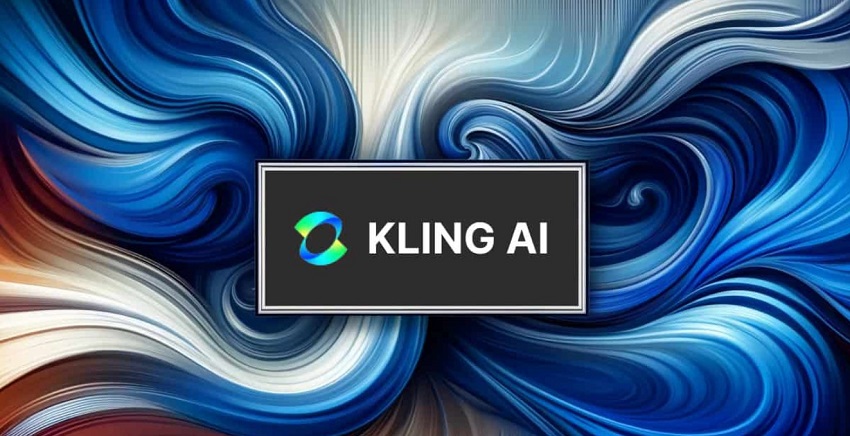
Unique Features
- Advanced Motion Simulation through 3D face and body reconstruction.
- Diverse Input Options such as text, images, lip-sync, and negative prompts.
- Flexible Aspect Ratios (1:1, 16:9, 9:16) for various platforms.
- Image-to-Video Transformation using the "Multi-Image Reference" feature.
- Extended Video Length for paid users, up to 3 minutes.
- Built-in Lip-Syncing for natural character dialogue.
- AI Music for adding sound to videos.
- The Elements Feature allows users to upload images of people, animals, or objects and guide their actions through prompts.
- Easy to Use interface suitable for beginners.
- High-Quality Output at 1080p resolution and 30 fps.
- Versatile Applications for various content creation needs.
- Cost-Effective with free and paid plans.
- Constant Updates with new features.
- Integration with Other Tools for creative flexibility.
- Global Availability.
- Limited Video Duration on the free plan.
- Inconsistent Output Quality, with occasional artifacts.
- Processing Time can be slow, especially on free and lower-tier plans.
- Some users have reported Customer Service Concerns.
- The Credit System can be restrictive for larger projects.
- Limited Built-in Editing Tools compared to other platforms.
- Potential Censorship due to being a Chinese model.
2. Hailuo AI
Hailuo AI, also known as MiniMax, is an AI-powered platform designed to facilitate video creation from text and image inputs. Its focus is on making video production accessible and effortless, aiming to turn ideas into captivating video content quickly and easily.
Hailuo AI utilizes advanced AI technology to generate high-quality videos based on text descriptions or images. It simplifies the video creation process, making it attractive to both beginners and those seeking to optimize their video production workflows. The platform provides a user-friendly design with a clear interface for inputting text prompts or uploading images.
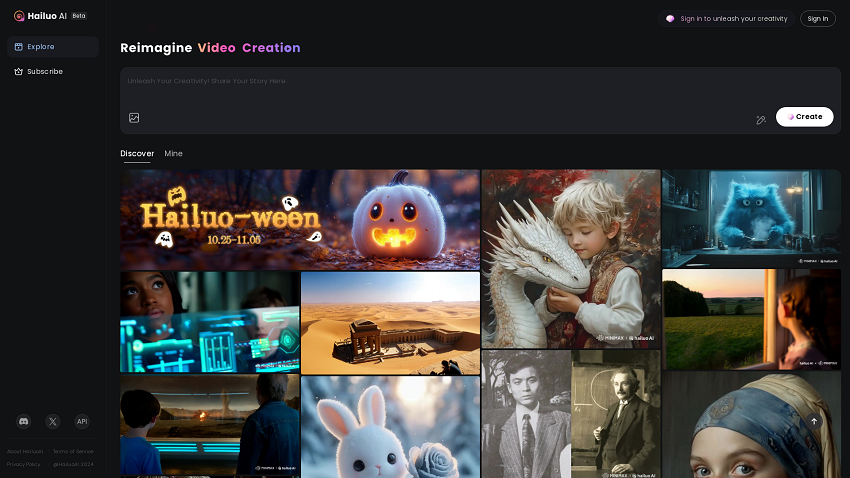
Unique Features
- Text-to-Video and Image-to-Video Generation: Hailuo AI can transform both written descriptions and still images into dynamic video content.
- Subject Reference: This feature allows users to maintain consistent character appearances across different scenes within a video.
- Exceptional Emotional Expression: The platform can generate videos with authentic and engaging character emotions.
- Prompt Refinement: This feature helps optimize text prompts for better video generation results.
- Multiple Models: Hailuo AI offers different AI models, including a "Director Model" for camera control and a "Live Model" for smoother character motion.
- Cinematic Effects: The platform can apply effects like dynamic lighting adjustments, color grading, and motion effects to enhance visual appeal.
- Multi-Language Support: Hailuo AI supports multiple languages, including strong performance in Chinese and English.
- Ease of Use: The platform's interface is designed to be intuitive and accessible for users of all levels.
- Rapid Video Creation: Hailuo AI excels at generating short videos quickly, making it suitable for social media content.
- Cost-Effectiveness: When accessed through platforms like Share Tool, it can be a cost-effective option.
- High-Quality Output: Hailuo AI can produce videos with professional-grade quality, suitable for marketing and socia l media content.
- Free Plan Availability: Hailuo AI offers a free plan with daily credits for basic video creation.
- Mobile and Desktop Support: The platform offers a seamless experience across devices, providing flexibility for users.
- Short Video Duration: Videos generated by Hailuo AI, particularly on the free plan, are limited in length.
- Limited Customization Options: Users may find the customization options less extensive compared to other tools.
- Occasional Inconsistencies: Some users have reported varying results, with videos not always matching the prompt perfectly.
- Resource-Heavy: The platform can sometimes cause browser lag or freezing.
- Limited Editing Features: The free version, in particular, may have restricted editing capabilities.
- Customer Support Concerns: Some users have expressed concerns about customer support responsiveness and issues with credits.
3. HunyuanVideo
HunyuanVideo model comes from Tencent, a leading Chinese tech company, has ventured into the AI video generation space. While still under development and with some limitations, it has shown promising potential as an open-source alternative to commercial models like OpenAI's Sora.
HunyuanVideo is a text-to-video generation model, allowing users to create video clips from written prompts. Its focus is on cinematic quality and realism, aiming to capture realistic motion and scene transitions. Tencent also offers other AI video-related services, such as video processing and avatar generation, through its Tencent Cloud platform.
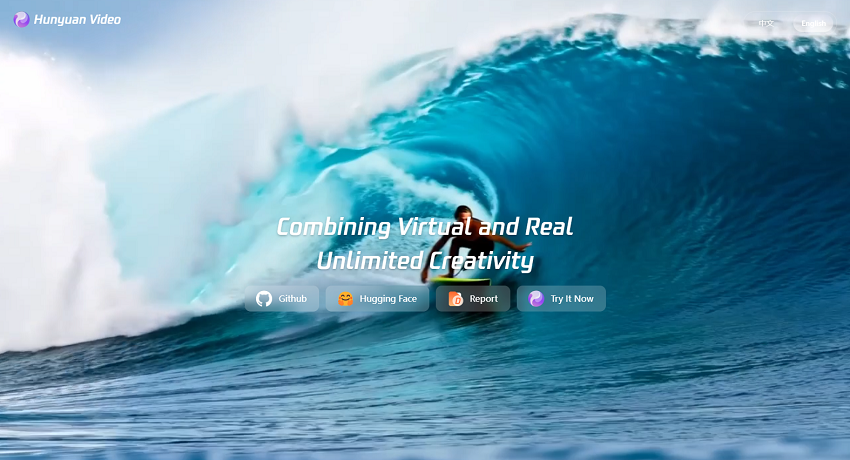
Unique Features
- Cinematic Video Quality: Strives for cinematic visual fidelity, motion stability, and smooth transitions.
- Prompt Refinement: Features a built-in model to automatically refine user prompts for better results.
- Emphasis on Chinese Aesthetics: Known for its ability to generate videos reflecting traditional Chinese art and styles.
- Open-Source Nature: Code and pre-trained weights are publicly available, encouraging community innovation.
- AI Avatars (HunyuanVideo-Avatar): Tencent has also introduced a model specifically for animating avatars from photos and audio.
- High Visual Quality: HunyuanVideo aims to produce visually appealing outputs with realistic lighting and motion.
- Strong Semantic Understanding: The model can understand natural language and context well, leading to impressive results from simple prompts.
- Open Source Advantage: Open access fosters community development and experimentation.
- HD Quality Output: Delivers 720p native resolution for clear and detailed videos.
- Potentially Free Alternative: The open-source nature makes it a compelling free option compared to proprietary models.
- Short Video Length: Currently limited to generating short video clips, typically around 5 seconds.
- High Computing Power Requirements: Running the model locally requires significant GPU memory (e.g., 45GB).
- Limited Advanced Controls: Lacks features like frame-by-frame editing or built-in audio generation.
- Inconsistent Output: May not always match complex prompts perfectly.
- Potential Bias in Prompt Rewrite: The prompt rewrite feature could potentially alter the user's intent.
4. Wan 2.1
Wan 2.1, also known as Wanx 2.1 or Tongyi Wanxi, is an open-source AI video model developed by Alibaba Cloud. It's part of the Tongyi series of multimodal AI models and aims to democratize AI-driven video creation by making powerful tools accessible to a wider audience. Wan 2.1 focuses on generating high-quality videos from both text prompts and images, excelling in areas like complex movements and spatial relationships.
Wan 2.1 is designed to be both powerful and accessible, utilizing advanced AI techniques like Diffusion Transformer technology and a unique Video Variational Autoencoder (Wan-VAE). This combination allows it to create realistic, smooth videos with impressive motion quality and maintain consistency even at higher resolutions. The open-source nature of Wan 2.1, with its code and weights available on GitHub and Hugging Face, encourages community contributions and innovation.
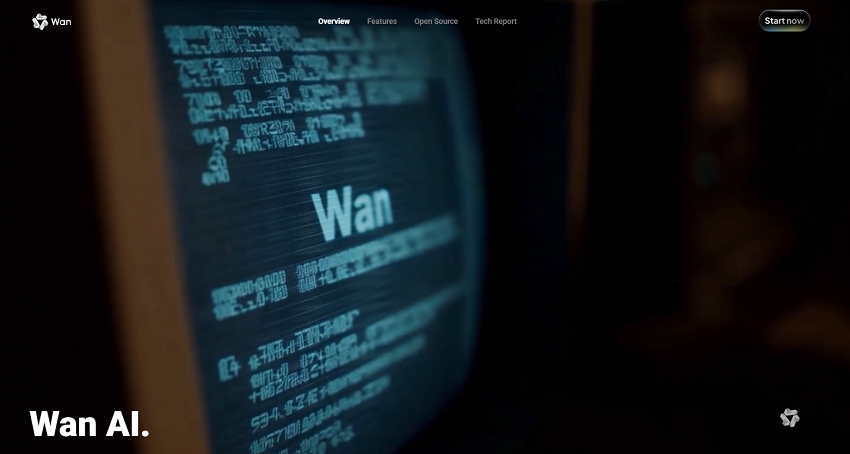
Unique Features
- Open-Source Accessibility: Wan 2.1 is free and open-source, allowing users to modify, adapt, and improve the tool. This fosters a community-driven development approach.
- Multilingual Text Integration: It's the first AI video model capable of generating legible text within videos in both Chinese and English. This is valuable for educational, marketing, and instructional content targeting diverse audiences.
- Consumer-Grade GPU Compatibility: Certain variants, like the T2V-1.3B model, can run on consumer-grade GPUs with as little as 8.19 GB of VRAM, making it accessible to a wider range of users.
- Superior Performance on Benchmarks: Wan 2.1 consistently outperforms existing open-source and commercial solutions across various benchmarks, especially in areas like motion smoothness, spatial relationships, and temporal consistency.
- Diverse Task Capabilities: Beyond text-to-video and image-to-video generation, Wan 2.1 supports video editing, text-to-image creation, and video-to-audio conversion.
- Prompt Enhancement: Wan 2.1 offers a built-in feature to automatically refine user prompts, leading to higher-quality and more precise video generations.
- Free and Open-Source: Accessible to a wide range of users without licensing fees.
- Community-Driven Development: Allows for modification, adaptation, and improvement by users.
- High-Quality Output Potential: Capable of generating realistic and cinematic-quality videos.
- Flexible Video Ratios: Supports various aspect ratios (16:9, 9:16, 1:1, 4:3, 3:4).
- Consumer-Friendly Hardware Requirements: Accessible to users with consumer-grade GPUs.
- Versatile Applications: Suitable for various use cases, including social media, advertising, education, and film production.
- Potential for Inconsistent Output: As an open-source model, performance can vary depending on how it's fine-tuned.
- High Compute Requirements for Local Installation: Running certain models locally may require significant VRAM and processing power.
- Platform Congestion: Hugging Face, where Wan 2.1 is available, can experience congestion, potentially slowing down video generation.
- Limited Built-in Editing Tools: May lack the extensive editing capabilities found in some proprietary platforms.
- Potential for Output Not Matching Prompts: While it strives for high prompt compliance, results may not always perfectly reflect complex or abstract prompts.
5. Baidu AI Video
Baidu, a major player in the Chinese technology landscape, offers various AI-driven video capabilities, primarily focused on its VidPress tool and the integration of its Ernie large language model within its ecosystem. While it doesn't offer a single, unified "Baidu AI Video" generator in the same way as platforms like Kling or Hailuo, it provides a range of services that enable users to leverage AI for video production.
Baidu's AI video services are centered around automating the video creation process, particularly for news and short-form content. Its VidPress tool, for example, can automatically generate narrated videos from text articles, showcasing its ability to synthesize information and create video narratives. Baidu also integrates its Ernie model within various applications to enhance its multimodal capabilities and allow users to generate content from different formats.

Unique Features
- VidPress Automation: VidPress excels at automatically generating video summaries of text articles, creating narrated videos with synchronized voice-overs and visuals.
- Text and Voice Synthesis: VidPress combines natural language processing and text-to-speech services to generate narratives and voice-overs for its videos.
- Data Integration: Baidu leverages its vast data resources, including a large repository of short videos from its platforms like Haokan, to enhance the accuracy and relevance of its AI-generated content.
- Multimodal Capabilities (Ernie): Baidu's Ernie model allows for seamless integration of text, images, audio, and video, providing enhanced content creation capabilities within its ecosystem.
- Focus on News and Information: VidPress's ability to create news video summaries from text articles makes it valuable for media companies and news organizations seeking to automate content production.
- Efficient Video Production: Baidu's AI video tools can significantly reduce the time and effort required to produce video content, particularly for news and information-based videos.
- Cost Savings: Automated video production can lead to significant cost savings compared to traditional video editing methods.
- High Viewership Potential: Videos generated by VidPress have demonstrated high viewership rates on platforms like Haokan.
- Leverages Baidu's Ecosystem: Baidu's AI video capabilities are integrated within its ecosystem, providing access to its vast data resources and other AI services.
- Limited Customization: The automated nature of VidPress may limit the extent to which users can customize the generated videos.
- Primary Focus on News: VidPress is primarily designed for generating news video summaries, which may not be suitable for all types of video content.
- Language Restrictions: VidPress currently only works with the Mandarin language, which may be a limitation for users who need to generate videos in other languages.
- Limited Availability: Some of Baidu's AI video services may be primarily targeted at the Chinese market, with restrictions on overseas account registration and usage.
- Not a Standalone Generator: Baidu's AI video capabilities are primarily integrated within its existing platforms and services, rather than being offered as a standalone video generation tool.
6. ByteDance AI Video
ByteDance, the parent company of TikTok, has emerged as a significant player in the AI video generation space, particularly with its focus on creating highly realistic human videos from minimal input. Their flagship model, OmniHuman, is revolutionizing the way digital content is produced and is a key component in various ByteDance AI video offerings.
ByteDance's AI video endeavors are driven by the development of sophisticated models like OmniHuman and its related applications. The core focus is on generating lifelike human videos from limited data, such as a single image and audio or video input. This technology has the potential to transform various industries, including entertainment, marketing, and communication.
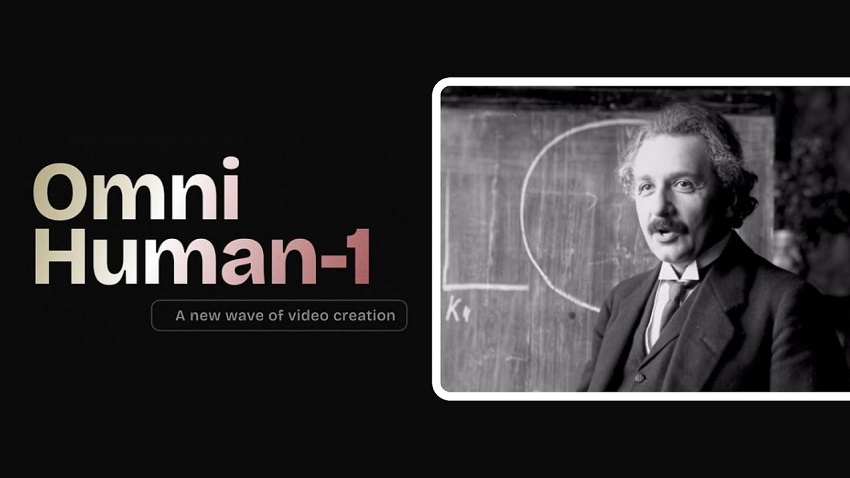
Unique Features
- OmniHuman Framework: OmniHuman is an end-to-end AI framework that synthesizes natural human motion, accurate lip sync, and realistic expressions from minimal input. It supports diverse inputs like text, audio, and pose, and can handle various image types (portrait, half-body, full-body).
- Realistic Human Video Generation: OmniHuman excels at generating videos of people speaking, singing, and moving naturally, capturing subtle details that enhance authenticity.
- Goku AI: A tool powered by OmniHuman that creates hyper-realistic videos featuring synthetic personas from a single photo and audio clip. It's designed for applications like virtual influencers, educational content, and marketing campaigns.
- Phantom Video Generation Tool: This tool focuses on subject reference generation, allowing users to maintain consistent subject appearances even in complex scenes with multiple subjects. It can accurately replicate and restore details like facial features and clothing, resulting in highly realistic and immersive videos.
- LatentSync Lip Sync Model: A cutting-edge model that enables seamless lip sync for talking-head content, enhancing the realism of AI-generated avatars.
- BytePlus Effects: A suite of AI video filters designed for lifestyle influencers and marketers, offering advanced features like automatic lighting and color correction, background removal, and facial feature enhancement.
- BytePlus MediaLive: A real-time AI video editing platform that leverages AI to streamline video production and reduce editing time. It offers features like intelligent scene recognition, automatic color correction, and multi-platform content optimization.
- Symphony Creative Studios: An AI-powered platform for advertisers on TikTok that automates the creation of video ads from product listings and generates AI avatars speaking in multiple languages.
- Exceptional Realism: ByteDance's AI models are capable of generating highly realistic human videos, capturing subtle nuances in expressions and movements.
- Efficient Content Production: Tools like Goku AI and Phantom allow for fast and cost-effective video creation, eliminating the need for traditional studio setups and actors.
- Broad Applications: ByteDance's AI video technology has diverse applications across various industries, including entertainment, marketing, education, and broadcasting.
- Advanced Features: The company offers a wide range of AI-powered features, including lip sync, subject consistency, advanced editing tools, and multilingual support.
- Potential for Scalability: ByteDance's AI models and tools enable efficient and scalable content creation, supporting businesses and influencers in producing high-quality content quickly and easily.
- Limited Public Access: Some of ByteDance's most advanced AI video models, like OmniHuman and Goku AI, may not be readily available for public use.
- Ethical Concerns: The potential for misuse of highly realistic human video generation technology raises ethical concerns regarding deepfakes and the spread of misinformation.
- High Computing Power Requirements: Running advanced AI video models locally may require significant computational resources.
- Potential for Output Not Matching Prompts: While ByteDance's models are highly capable, they may not always perfectly match complex or abstract prompts.
- Focus on Specific Applications: Some ByteDance AI video tools, like Goku+ and Symphony Creative Studios, are tailored for specific applications like product advertising and business marketing.
7. Seedance AI
Seedance AI is a notable AI video generation platform, specifically focusing on image-to-video creation with cinematic camera movements. While it's associated with ByteDance, its core focus differentiates it from ByteDance's broader AI video offerings like OmniHuman which focuses on realistic human synthesis.
Seedance AI (specifically Seedance 1.0) is a platform that uses AI to transform static images into dynamic video content. It emphasizes generating videos with professional cinematic camera movements and achieving a high level of visual detail. It offers both a "Lite" version for faster generation and a "Pro" version with expanded parameters for more nuanced and temporally consistent long-form video creation.
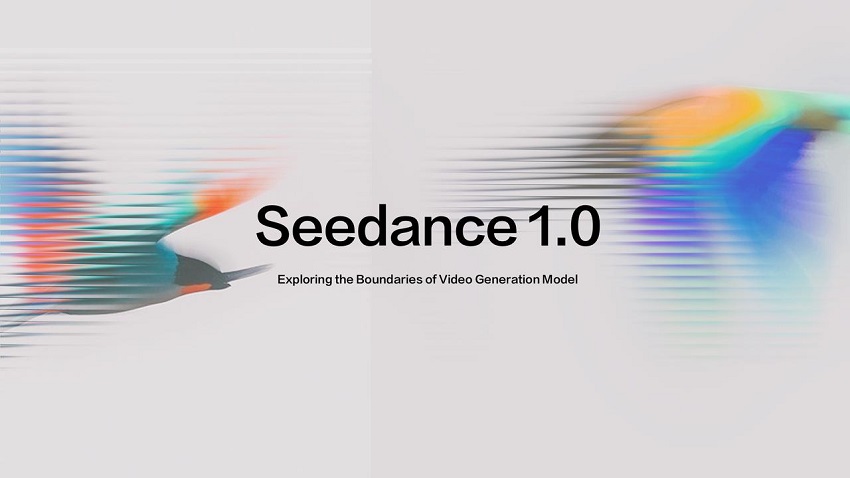
Unique Features
- Exceptional Image-to-Video Transformation: It excels at creating videos from images, adding elements like cinematic camera moves to enhance visual appeal.
- Cinematic Camera Movements: Supports a wide range of professional camera movements, adding depth and polish to generated videos.
- Fine-Grained Control: Allows users to define character appearance, emotions, clothing, and actions in detail.
- Multiple Character Interaction: Can handle scenes with multiple characters interacting, adding dynamic elements to videos.
- Resolution Options: Offers flexible resolution options, currently including 480p and 720p, with 1080p planned.
- Integration with Deevid AI: Seedance 1.0 is integrated into Deevid AI, making it readily accessible without needing server setups or API integrations.
- High-Quality Output: Generates videos with impressive detail, rich layers of tone, and a cinematic quality.
- Efficient and Fast: Seedance 1.0 Lite is designed for fast video generation without sacrificing quality.
- User-Friendly: Described as beginner-friendly, especially when accessed through platforms like Deevid AI.
- Versatile Applications: Can be used for various purposes, including marketing, education, and short film production.
- Limited Public Access: Availability outside of platforms like Deevid AI may be limited.
- Output Resolution Limitations: While 1080p is planned, it's not currently available.
- Potential for Inconsistent Output: As with any AI generator, results may not always perfectly match the desired outcome.
- Reliance on Text Prompts: Users need to provide clear and detailed prompts to guide the AI, which can be challenging for some.
Comparison Table of Best Chinese AI Video Generators
| AI Video Generator | Key Features | Best Use Cases | Pricing | Output |
|---|---|---|---|---|
| Kling AI | Cinematic, filmmaker-friendly, narrative-focused, text-to-video | Filmmakers, creative professionals | Subscription around $6.99/month | Up to ~10-second clips; 1080p resolution |
| Hailuo AI | Advanced facial animation, multi-language support, easy API integration | Developers, SMBs, storytelling | Subscription + usage fees, ~ $14.90/month | Up to 10 seconds; 100 free daily credits |
| HunyuanVideo | Real-time AI avatars, video editing features | Social media creators, influencers | Tiered subscription | Not specified |
| Wan 2.1 | Video summarization, scene detection, e-commerce focus | E-commerce, marketing automation | Pay-per-use | Not specified |
| Baidu AI Video | Text-to-video generation, voice synthesis, high-quality output | Enterprises, marketing teams | Pay-as-you-go | Up to 4K resolution; output length not explicit |
| ByteDance AI Video | Short video templates, AI-driven editing | Influencers, small businesses | Free + in-app purchases | Short videos, typically <10 seconds |
| Seedance AI | General-purpose AI video generation | General users | Not clearly disclosed | Not specified |
Conclusion
As we've explored, China's AI video generator landscape is both dynamic and innovative, offering a diverse array of tools tailored to different creative needs and technical expertise.
Platforms like Kling AI and Hailuo AI are democratizing video creation with user-friendly interfaces and rapid content generation, making high-quality video accessible to beginners and professionals alike.
HunyuanVideo and Wan 2.1 stand out for their open-source nature, empowering a global community of developers and creators to experiment, adapt, and push the boundaries of what AI-generated video can achieve.
Meanwhile, giants like Baidu are integrating AI into broader content ecosystems, automating everything from news video summaries to virtual production and script analysis.
Each solution has its unique strengths—whether it's cinematic realism, cost-effectiveness, multilingual support, or seamless workflow integration—alongside some limitations, such as video duration, customization, or hardware requirements.